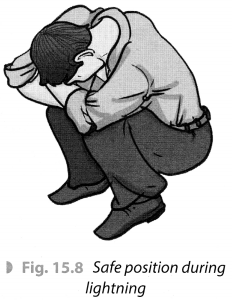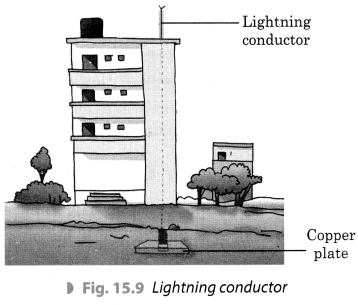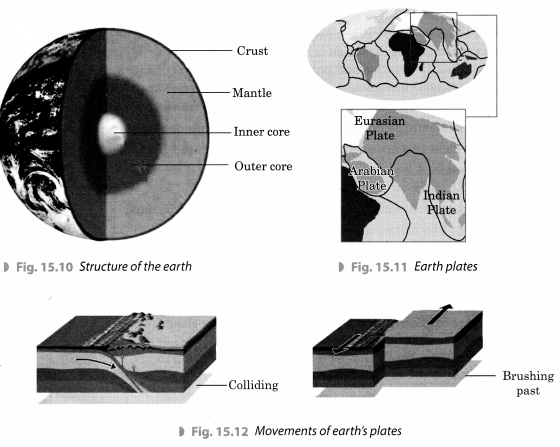In this page, we are providing Some Natural Phenomena Class 8 Extra Questions and Answers Science Chapter 15 pdf download. NCERT Extra Questions for Class 8 Science Chapter 15 Some Natural Phenomena will help to score more marks in your CBSE Board Exams.
Class 8 Science Chapter 15 Extra Questions and Answers Some Natural Phenomena
Extra Questions for Class 8 Science Chapter 15 Some Natural Phenomena with Answers Solutions
Some Natural Phenomena Class 8 Extra Questions Very Short Answer Type
Question 1.
What are the two natural calamities?
Answer:
- Lightning and
- Earthquake.
Question 2.
Name other natural calamities except lightning and earthquake.
Answer:
Winds, storms and cyclones.
Question 3.
Name the two types of charges.
Answer:
- Positive; and
- Negative.
Question 4.
Mention the interactions of two types of charges.
Answer:
Like charges repel each other while unlike charges attract each other.
Question 5.
Name the device used to protect buildings from lightning.
Answer:
Lightning conductor.
Question 6.
In which direction does the shock waves produced by an earthquake travel?
Answer:
Both on the surface and inside the earth.
Question 7.
What happens when two clouds with unlike charges approach each other?
Answer:
Lightning strikes
Question 8.
Who discovered the static electricity or lightning in clouds and when?
Answer:
Benjamin Franklin in 1752.
Question 9.
What actually causes lightning?
Answer:
Lightning is caused by the accumulation of charges in the clouds.
Question 10.
What happens when amber is rubbed with fur?
Answer:
It develops the capacity to attract light objects.
Question 11.
What is static electricity?
Answer:
The electrical charge reproduced by rubbing two objects is called static electricity.
Question 12.
What happens when a glass rod and silk cloth are rubbed with each other?
Answer:
The glass rod gets positively charged and silk cloth negatively charged.
Question 13.
What is lightning?
Answer:
Lightning is&an electric spark on huge scale.
Question 14.
What are weak zones called?
Answer:
Seismic or fault zones.
Question 15.
How are most earthquakes caused?
Answer:
Most earthquakes are caused by the movement of earth’s plates.
Question 16.
What is a plate?
Answer:
Each fragment of the outermost layer of the earth is called plate.
Question 17.
What is the uppermost layer of the earth called?
Answer:
Crust
Question 18.
How is an earthquake caused?
Answer:
It is caused by a disturbance deep inside the earth’s crust.
Question 19.
What are seismic waves?
Answer:
Waves produced on the Earth’s surface because of tremors.
Question 20.
When and where a major tsunami took place in India?
Answer:
It occurred in the Indian ocean on 26th December 2004.
Question 21.
What are the natural calamities caused by earthquakes?
Answer:
Earthquakes can cause floods, landslides and tsunamis.
Question 22.
Which kind of material is used to transfer charges from one body to another?
Answer:
Metal conductor
Some Natural Phenomena Class 8 Extra Questions Short Answer Type
Question 1.
What is lightning? What causes lightning?
Answer:
Lightning is also an electric spark, but on a huge scale. It is caused by the accumulation of charges in the clouds.
Question 2.
What is an electric charge? What are charged objects?
Answer:
When a plastic refill is rubbed with polythene it acquires a small electric charge. Similarly when a plastic comb is rubbed with dry hair, it acquires a small charge. These objects are called charged objects.
Question 3.
What is static charge? How does it differ from electric current? ‘
Answer:
The electric charges generated by rubbing are called static charges. The static charges do not move while charges move in electric current.
Question 4.
What do you mean by electric discharge? How does it occurs?
Answer:
When the negative and positive charges meet, streaks of bright light and sound are produced. This process is called electrical discharge. For example, electric discharge occurring between two or more clouds or between clouds and earth.
Question 5.
What is earthing? What is the application of earthing?
Answer:
The process of transfer of charges from a charged object to the earth is called earthing. It is provided in buildings to protect from electrical shocks due to any leakage of electrical current.
Question 6.
How does electric discharge occur in clouds?
Answer:
At the time of thunder negative charges are accumulated near the clouds and positive charges near the ground. When these charges meet, electric discharge takes place between the ground and clouds. In this process, a large amount of energy is released.
Question 7.
What is lightning conductor? Where is it fixed?
Answer:
Lightning conductor is a device which is used to protect buildings from the danger of lightning. It is fixed at the top of the building.
Question 8.
What is an earthquake? How is it caused?
Answer:
Sudden shaking and trembling of earth is called an earthquake. It is caused mostly due to the movement of earth’s plates inside the crust.
Question 9.
What are fault zones? Name the fault zones in India.
Answer:
Since earthquakes are caused by the movement of plates, the boundaries of the plates are weak zones where earthquakes are more likely to occur. The weak zones are also known as seismic or fault zones. In India the most threatened areas or fault zones are Kashmir, Western and Central Himalayas, the Indo-Gangetic Plain, Rann of Kutch, etc.
Question 10.
How can tremors be caused?
Tremors on the earth can also be caused when a volcano erupts, or a meteor hits the earth, or an underground nuclear explosion is carried out.
Question 11.
What are seismic waves? How are these waves recorded?
Answer:
The tremors produce waves on the surface of the earth. These are called seismic waves. These waves are recorded by an instrument called the seismograph.
Some Natural Phenomena Class 8 Extra Questions Long Answer Type
Question 1.
What is lightning? How does lightning strike?
Answer:
Lightning is an electric spark, but on a huge scale. It is caused by the accumulation of charges in the clouds. When two clouds carrying opposite charges come very close to each other, the charges flow with great speed from one cloud to another through the air between them. Consequently, a very bright spark is produced.
The spark caused due to the transfer of electric charge between two clouds causes lightning. It can occur when electric charges flow from one part of a cloud to another or from a cloud to the ground. Lightning is accompanied by large amounts of electric charges and very high temperatures. The huge amount of heat produced makes the air expand very suddenly what causes vibration to occur, resulting in a loud sound called thunder.
Question 2.
Explain the process of electric discharge.
Answer:
During the development of a thunderstorm, the air currents move upward while the water droplets move downward. These vigorous movements cause separation of charges. By a process, the positive charges collect near the upper edges of the clouds and the negative charges accumulate near the lower 1 edges. There is accumulation of positive near the ground also.
When the magnitude of the accumulated charges becomes very large, the air which is normally a poor conductor of electricity, is no longer able to resist their flow. Finally negative and positive charges meet, producing streaks of bright light and sound called lightning and thunderstorm respectively. This process is known as electric discharge. This can occurs between two or more clouds, or between clouds and the earth.
Question 3.
What safety measures should be taken during lightning and thunderstorm?
Answer:
The following safety measures are advisable to be adopted to protect from lightning and thunderstorm:
- No open place is safe. A house or a building is a safe place. If travelling by car or by bus, it is safe to stay inside with windows and doors of the vehicle shut.
- If we are outside, the following things are important to be kept in mind:
(a) Open vehicles, like motorbikes, tractors, construction machinery, fields, tall trees, shelters in parks, elevated places do not protect us from lightning strikes.
(b) Carrying an umbrella is not at all a good idea during thunderstorms.
(c) If no shelter is available and we are in an open field, we should keep away from all trees. We should stay away from poles or other metal objects. We should not lie on the ground. Sitting in a pose as given in the Fig. 15.8 is advisable.

- If we are inside the house, we should take care as advised further: Lightning can strike telephone cords, electrical wires and metal pipes. During a thunderstorm, contact with these should be avoided. It is safer to use mobile phones and cordless phones. However, it is not wise to call up a person with a wired phone. Bathing should be avoided. Electrical appliances should be unplugged.
Question 4.
What is a lightning conductor? How does it work?
Answer:
Lightning conductor is a device used to protect buildings from the effect of lightning. A metallic rod, taller than the building, is installed in the walls of the buildings during its construction. One end of the rod is kept out in the air and the other is buried deep in the ground as shown in the figure. The rod provides easy route in the transfer of electric charge to the ground. The metal columns used during construction, electrical wires and water pipes in the buildings also protect us to an extent. But we should not touch them during thunderstorm.

Question 5.
What is an earthquake? What causes an earthquake? Explain.
Answer:
An earthquake is a sudden shaking or trembling of the earth. It lasts for a very short time. It is caused by a disturbance deep inside the earth’s crust. We know that tremors are caused by the disturbance deep down inside the uppermost layer of the earth called crust (Fig. 15.10). The outermost layer of the earth is fragmented. Each fragment is called a plate (Fig. 15.11). These plates are in continual motion. When they brush one another, or a plate goes under another due to collision (Fig. 15.12), they cause disturbance in the earth’s crust. It is this disturbance that shows up as an earthquake on the surface of the earth.

Question 6.
What are the measures we should adopt to protect against an earthquake?
Answer:
We know that earthquakes cannot be predicted. It is, therefore, important that we should take necessary precautions to protect ourselves all the time as given below:
- In seismic zones it is advisable to make the structure of the buildings simple so that it is ‘Quake Safe’. Modern building technology can make it possible.
- In highly seismic areas, the use of mud or timber is better than using heavy construction materials.
- Since some buildings may catch fire, it is necessary that all buildings, especially tall buildings, have fire fighting equipment in working order.
- If we are at home, we should take shelter under a table and stay there till the shaking stops. We should stay away from tall and heavy objects that may fall on us. If we are in bed, we should protect our head with a pillow.
- If we are at outdoors, we should find a clear spot, away from buildings, trees and overhead power lines and drop to the ground. If travelling in a car or a bus, do not come out and drive slowly to a clear spot.
Some Natural Phenomena Class 8 Extra Questions HOTS
Question 1.
If aluminium strips of an electroscope are replaced by plastic strips and a charged body is brought in contact with the metal clip. What will happen?
Answer:
The plastic strips will show repulsion. Charges from the charge body will be transfer from the metal rod to the plastic strips. As a result, similar charges will develop on the plastic strips and repulsion will occur.
Question 2.
If a charged plastic straw is brought near another uncharged plastic straw, what will happen?
Answer:
They will attract each other due to presence of unlike charges on them.
Question 3.
During construction of a building, the lightning conductor was a little shorter and cannot be buried in the ground. Would the lightning conductor be still effective? Explain.
Answer:
No, it will not be effective. Since lightning conductor was not connected properly to the earth, therefore, the charge will not pass through to the earth.
Question 4.
If air and cloud were good conductors of electricity, do you think lightning could occur? Explain.
Answer:
If air and cloud were good conductors of electricity then charge separation will not take place and hence lightning will not occur.
Question 5.
The strips of an electroscope diverge when a charged body is brought in contact with the metal clip.
What will happen to the strips if we gently touch the metal clip with hands?
Answer:
The strips will collapse due to discharging of the charges through our hand.
Question 6.
On a dry day why do you get a slight shock on touching the screen of a television or computer monitor (with picture tube)?
Answer:
Electric charges accumulated on the screen of television or computer monitor get discharge through our body. Thus, we get a slight shock.
Some Natural Phenomena Class 8 Extra Questions Value Based (VBQs)
Question 1.
Ms Neena, Science teacher of class VIII, taught children how to protect themselves and what to do during an earthquake. She even performed an earthquake drill in school for better understanding in children. Children enjoyed this drill and learned a lot from this.
(a) What to do during an earthquake if you are stuck indoor?
(b) What causes earthquakes?
(c) How you must keep yourself ready for an earthquake?
(d) What values of Ms Neena is shown here?
Answer:
(a) The following must be done if someone had stuck indoor:
- Stay away from glass, windows, outside doors and walls.
- Stay away from anything that could fall such as lightning fixtures or furnitures.
- Get under a sturdy table/desk, hold it firmly and cover your head.
- Stay calm and do not panic. Stay inside until shaking stops and it is safe to go outside.
(b) Earthquakes are usually caused when rock underground suddenly breaks along a fault. This sudden release of energy causes the seismic waves that make the ground shake.
(c) We must keep ourself ready for an earthquake by:
- Having proper knowledge about do’s and don’ts during an earthquake.
- Keeping a disaster kit ready in the time of need.
- Helping needy and injured person after an earthquake.
(d) Ms Neena has future vision, scientific temperament, intelligent, compassionate, caring, dedicated, etc.